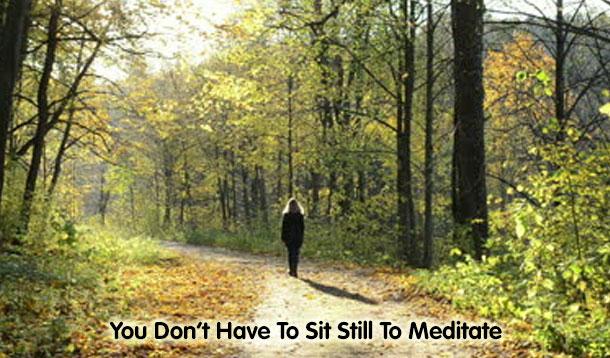
In my last post, I shared a key piece of advice for anyone who wants to start meditating—all you need to do to start meditating is simply start a meditation practice. Stop. Sit. Breathe. Repeat.
But what if you’re the type who would love to meditate, but can’t sit still for 30 seconds? What if your mind is a constant flow of thoughts and you can’t imagine it ever being quiet in there?
I completely relate to this. Having been a runner and an athlete all my life, seated meditation was a difficult sell for me when I first began studying yoga. But did you know you don’t need to sit still to meditate? Mindful meditation is about observing the breath and the mind, and learning to separate yourself from your thoughts.
We can achieve this just as easily during active meditation or what I like to refer to as “moving into stillness.”
Here are a few of my favourite types of meditation through movement :
Running Meditation: During a running meditation become aware of your breathing, of the movements of the body, the repetitive motion of your arms swinging and your feet hitting the ground. Let your breathing follow the rhythm of your stride. For example, inhale for three or four steps and exhale for three or four steps. Imagine opening a trap door at the back of your head and leaving all thoughts of your day/week/month behind you as you move forward. If a thought continues to intrude on your mind, observe the thought, then bring your attention back to your breath, your running rhythm, and the movement of your body. If you’re a runner and have experienced “the zone,” then you have meditated. (This meditation can be done with any type of repetitive cardio exercise, such as swimming or cross-country skiing.)
Walking Observation Meditation: Similar to the running meditation, the walking meditation involves bringing awareness to your breathing and the movements of your body. Once you have found your walking rhythm, begin to take in your environment as you walk. Observe the sights, sounds, and smells that you are surrounded by. If the mind begins to wander, focus again on the breath and being present right now. Return your attention to what is around you, and be mindful of each moment.
Active Gratitude Meditation: This can be done during walking, running, or any kind of repetitive physical activity. Decide on the length of the activity, and begin the activity by connecting with your breathing. Once you have a steady breathing rhythm, let your mind focus on the things you are grateful for. For the duration of the activity, allow yourself to explore how much you have to be thankful for in your life. If your mind veers off into other thought streams, return to your breathing and to the idea of gratitude.
Yoga: This is the epitome of meditation through movement. As you practice the physical postures, you are deepening the awareness of your body and your mind. As you move through or hold poses, you are encouraged to stay connected to your breath, letting your thoughts drift through the mind without attaching any weight to them. By maintaining your focus on the breath and the body, the mind will often become quiet, while the body stretches and strengthens.
These are the types of meditation I was first drawn to, and was amazed at the feeling of calm and quiet in my mind after a physical activity. Gradually, I started trying seated meditation for small amounts of time and grew to love both equally. Now I simply check-in each day and determine whether it’s one of those days where I need to sit to find stillness or whether I need to physically move into stillness.
If you're new to meditation, you might appreciate these important tips:
1. Your mind will never be completely silent. Meditation will teach you to observe thoughts and not attach weight to them. The image that I like to use with clients is to consider thoughts, like clouds passing through the sky. They will never go away. But we can learn to acknowledge them, and let them pass through.
2. You don’t “get good” at meditation. There are days when I find meditating just as difficult as the first few times I tried it. Then there are other days when my mind becomes calm and clear with seeming ease. What is most important is the act of continuing to meditate. This is why it is called a practice.
If you're into movement, you might want to check out Three Poses To Maintain Good Running Posture, or get your zen on with this Outdoor Yoga Sequence.